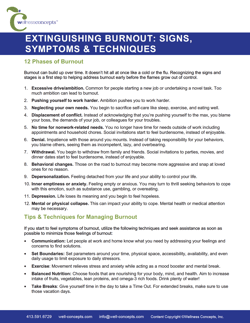12 Phases of Burnout
Burnout can build up over time. It doesn’t hit all at once like a cold or the flu. Recognizing the signs and stages is a first step to helping address burnout early before the flames grow out of control.
- Excessive drive/ambition. Common for people starting a new job or undertaking a novel task. Too much ambition can lead to burnout.
- Pushing yourself to work harder. Ambition pushes you to work harder.
- Neglecting your own needs. You begin to sacrifice self-care like sleep, exercise, and eating well.
- Displacement of conflict. Instead of acknowledging that you’re pushing yourself to the max, you blame your boss, the demands of your job, or colleagues for your troubles.
- No time for nonwork-related needs. You no longer have time for needs outside of work including appointments and household chores. Social invitations start to feel burdensome, instead of enjoyable.
- Denial. Impatience with those around you mounts. Instead of taking responsibility for your behaviors, you blame others, seeing them as incompetent, lazy, and overbearing.
- Withdrawal. You begin to withdraw from family and friends. Social invitations to parties, movies, and dinner dates start to feel burdensome, instead of enjoyable.
- Behavioral changes. Those on the road to burnout may become more aggressive and snap at loved ones for no reason.
- Depersonalization. Feeling detached from your life and your ability to control your life.
- Inner emptiness or anxiety. Feeling empty or anxious. You may turn to thrill seeking behaviors to cope with this emotion, such as substance use, gambling, or overeating.
- Depression. Life loses its meaning and you begin to feel hopeless.
- Mental or physical collapse. This can impact your ability to cope. Mental health or medical attention may be necessary.
Tips & Techniques for Managing Burnout
If you start to feel symptoms of burnout, utilize the following techniques and seek assistance as soon as possible to minimize those feelings of burnout:
- Communication: Let people at work and home know what you need by addressing your feelings and concerns to find solutions.
- Set Boundaries: Set parameters around your time, physical space, accessibility, availability, and even daily usage to limit exposure to daily stressors.
- Exercise: Movement relieves stress and anxiety while acting as a mood booster and mental break.
- Balanced Nutrition: Choose foods that are nourishing for your body, mind, and health. Aim to increase intake of fruits, vegetables, lean proteins, and omega-3 rich foods. Drink plenty of water!
- Take Breaks: Give yourself time in the day to take a Time Out. For extended breaks, make sure to use those vacation days.
- Relaxation Techniques: Try mindfulness, meditation, breathing exercises, yoga, music, or massage to create calmness in your day. See App recommendations below to help get started.
- Get Quality Sleep: Aim for 7-9 hours of sleep. Get a good night’s sleep by unplugging an hour before bedtime, doing some relaxing activities to wind down, and limit stressful activities at night.
- Ask for Help or Seek Support: Talk to your support network, explore support group options, or even seek professional assistance to help address your burnout symptoms. Check out your Employee Assistance Program (EAP) benefits.
What Drains or Sustains You?
Sustains: Strengthens or supports you physically or mentally
Create a list of all the thing you love and that sustain your energy
Drains: Deprives you of strength or vitality
Create a list of all the thing you drain you and leave you feeling depleted
Which of these lists are you currently living in and giving power to?
If there are items on your list that drain you, what can you do to address or shift those to become more positive?
Put this list where you can see it as a daily reminder.
Apps for Stress Management & Mental Health
Talkspace: Connects you with a licensed mental health professional so you can receive therapy from your digital devices.
MoodMission: Helps people who are dealing with stress, anxiety, or depression. The app recommends “missions” based on how the user is feeling.
Sanvello: Provides clinically validated techniques for dealing with stress, anxiety, and depression.
Headspace: Provides options for meditation, breathing exercises, sleep, and soundscapes.
Calm: Provides options for meditation, breathing exercises, Sleep Stories, and more.
Breethe: Meditations and breathing exercises help address anxiety, stress, sleep, and more.


